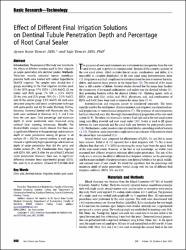| dc.contributor.author | Kara-Tuncer, Aysun | |
| dc.contributor.author | Tuncer, Safa | |
| dc.date.accessioned | 10.07.201910:49:13 | |
| dc.date.accessioned | 2019-07-10T19:58:03Z | |
| dc.date.available | 10.07.201910:49:13 | |
| dc.date.available | 2019-07-10T19:58:03Z | |
| dc.date.issued | 2012 | en_US |
| dc.identifier.citation | Kara-Tuncer, A. ve Tuncer, S. (2012). Effect of different final irrigation solutions on dentinal tubule penetration depth and percentage of root canal sealer. Journal of Endodontics, 38(6), 860-863. https://dx.doi.org/10.1016/j.joen.2012.03.008 | en_US |
| dc.identifier.issn | 0099-2399 | |
| dc.identifier.issn | 1878-3554 | |
| dc.identifier.uri | https://dx.doi.org/10.1016/j.joen.2012.03.008 | |
| dc.identifier.uri | https://hdl.handle.net/20.500.12511/3099 | |
| dc.description | WOS: 000304691200026 | en_US |
| dc.description | PubMed ID: 22595128 | en_US |
| dc.description.abstract | Introduction: The purpose of this study was to evaluate the effects of different solutions used for final irrigation on sealer penetration into dentinal tubules. Methods: Thirty-two recently extracted human mandibular premolar teeth were treated with sodium hypochlorite (NaOCl) irrigation. The samples were divided into 4 groups according to the final irrigation solution used: (1) the EDTA group: 17% EDTA + 2.5% NaOCl, (2) the maleic acid (MA) group: 7% MA + 2.5% NaOCl, (3) the citric acid (CA) group: 10% CA + 2.5% NaOCl, and (4) the control group: 2.5% NaOCl. All teeth were obturated using the cold lateral condensation technique with gutta-percha and AH 26 sealer (Dentsply; DeTrey, Konstanz, Germany) labeled with fluorescent dye. The teeth were sectioned at distances of 2, 5, and 8 mm from the root apex. Total percentage and maximum depth of sealer penetration were measured using confocal laser scanning microscopy. Results: The Kruskal-Wallis analysis results showed that there was a significant difference in the percentage and maximum depth of sealer penetration among all groups in all sections (P<.05). The coronal sections in each group showed a significantly higher percentage and maximum depth of sealer penetration than did the apical and middle sections (P<.05). Conclusions: Final irrigation with EDTA, MA, and CA after the use of NaOCl affected sealer penetration. However, there was no significant difference between these experimental groups (EDTA, MA, and CA) in all sections. | en_US |
| dc.language.iso | eng | en_US |
| dc.publisher | Elsevier | en_US |
| dc.rights | info:eu-repo/semantics/openAccess | en_US |
| dc.subject | Citric Acid | en_US |
| dc.subject | Dentinal Tubule | en_US |
| dc.subject | Irrigation | en_US |
| dc.subject | Maleic Acid | en_US |
| dc.subject | Sealer | en_US |
| dc.title | Effect of different final irrigation solutions on dentinal tubule penetration depth and percentage of root canal sealer | en_US |
| dc.type | article | en_US |
| dc.relation.ispartof | Journal Of Endodontıcs | en_US |
| dc.department | İstanbul Medipol Üniversitesi, Diş Hekimliği Fakültesi, Endodonti Ana Bilim Dalı | en_US |
| dc.identifier.volume | 38 | en_US |
| dc.identifier.issue | 6 | en_US |
| dc.identifier.startpage | 860 | en_US |
| dc.identifier.endpage | 863 | en_US |
| dc.relation.publicationcategory | Makale - Uluslararası Hakemli Dergi - Kurum Öğretim Elemanı | en_US |
| dc.identifier.doi | 10.1016/j.joen.2012.03.008 | en_US |
| dc.identifier.wosquality | Q1 | en_US |
| dc.identifier.scopusquality | Q1 | en_US |


















